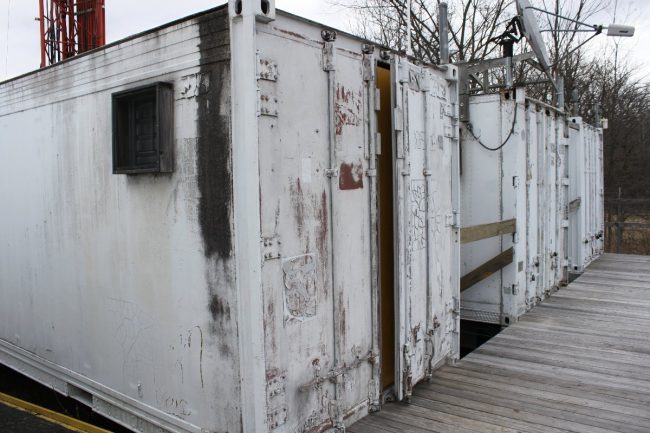
I do not particularly like these. I know, they are relatively inexpensive, easy to come by, easy to install, etc. However, a shipping container was not designed to house a transmitter, they have certain drawbacks. These are, in no particular order:
- Air conditioning. Using a traditional Bard-type equipment shelter HVAC unit requires cutting through a lot of fairly heavy gauge steel. What’s more, the steel walls are uneven, requiring a filler.
- They are by necessity, fairly narrow. Arranging racks and transmitters along the length of the unit restricts access to either the front or the back of the equipment. Meeting NEC clearance requirements for electrical panels, transfer switches, and disconnects can pose problems.
- They are not very tall. Mounting overhead equipment can be problematic as one does not want to drill through the top of the container. Crosswise unistrut is one solution, but it lowers the overhead considerably.
- Electrical work is slightly more dangerous. Doing any kind of electrical work, troubleshooting, repairs, etc is a little more nerve-racking when everywhere around you is a metal surface at ground potential.
- They are difficult to insulate against cold and heat.
- The door-latching mechanisms bind, wear out or otherwise fail over time.
All of those things being said, I am now rebuilding a transmitter site in one of these shipping containers.
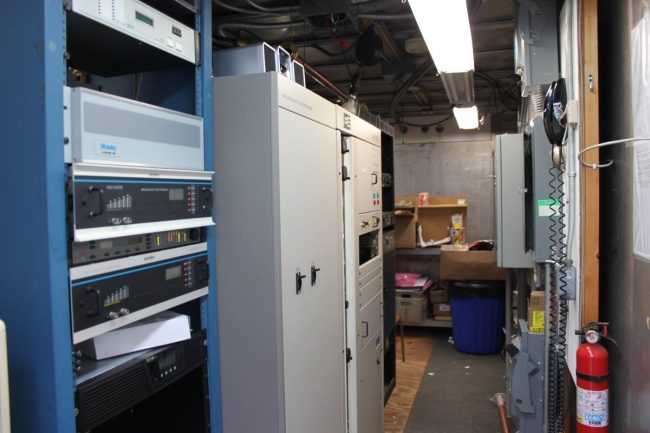
Fortunately, the original electrical work was not bad. The transmitter is a twenty-year-old BE FM10B, which will be retained as a backup. The new transmitter is a Gates Air FAX-10. We have installed several of these Gates Air transmitters in the last two years or so and they seem to be pretty solid units. This is the second 10KW unit I have installed.
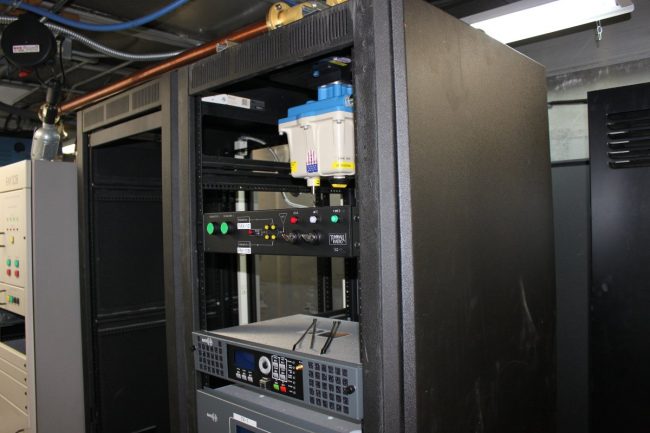
We decided to install the FAX-10 in a Middle Atlantic rack since we did not have a whole bunch of extra room for a separate transmitter rack. The 1 5/8 inch coax switch is installed in the top of the transmitter rack along with a Tunwall TRC-1 switch control unit. The other rack will have the STL and all other ancillary gear. My idea is to have nothing in between the door and the FM10B so it can be easily removed when that day comes. Something, something about planning ahead since it will be likely myself removing the FM10B.


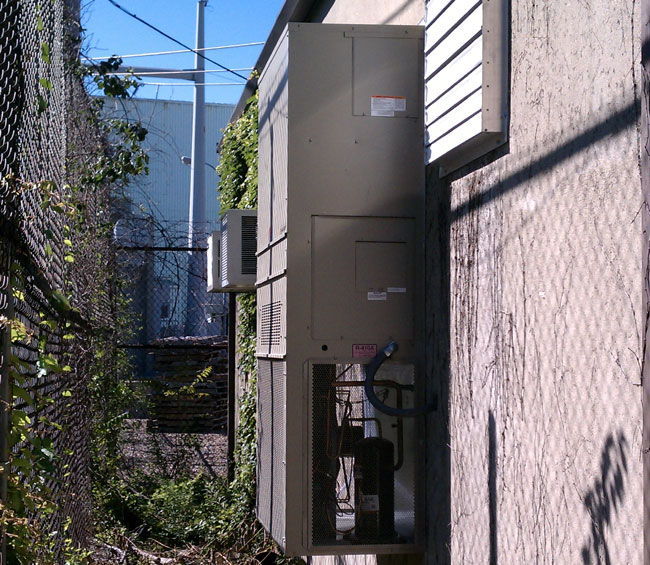
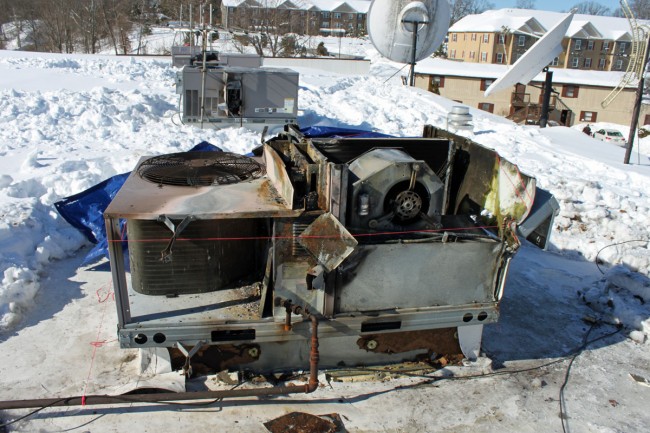
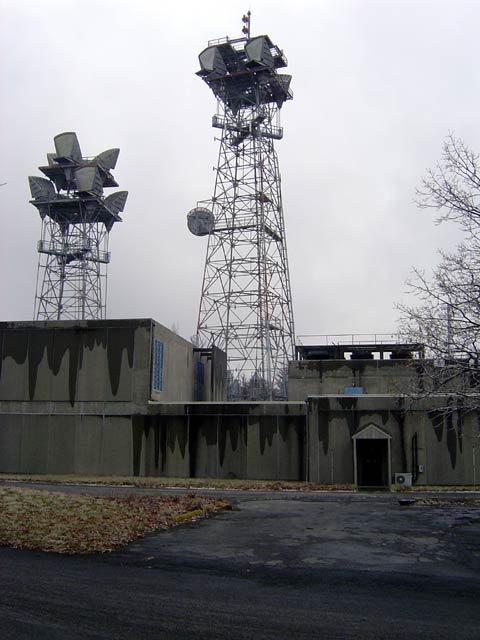
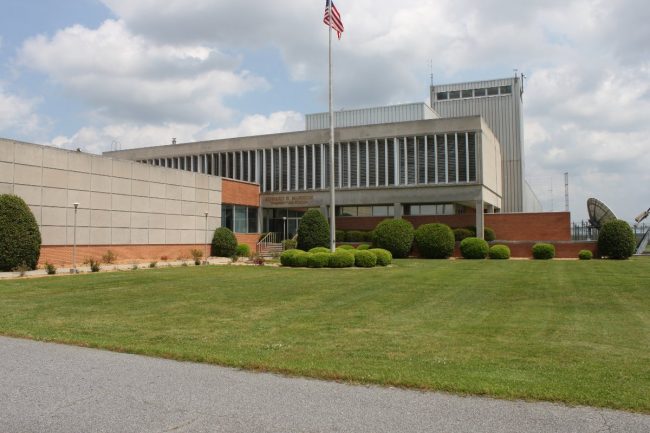
On a similar installation that I observed, standing water on the flat roof caused it to rust through and leak water on to the transmitter. That container would also become an oven when the air conditioning failed.
Looks like a nice installation, Paul!
These containers are aluminum. I would know since it was my Sawzall that cut the holes for a few of the Clima-tel wall-mount air conditioners at this site. We used carriage bolts to draw the frames of the wall-mount units into 2×4 lumber on the interior side along with caulking compound to make an airtight seal. At least that was the intention. The breaker panel clearances are very dangerous and may violate NEC codes as Paul stated. There is no insulation at all. It was very important to have a thermostatically controlled exhaust fan and louver as back-up for those dog-days of summer when the air conditioners would fail. The tube transmitters could take it but time will tell how well the solid state transmitters will tolerate it. My favorite place to pee was off the end of the deck to the right of the third trailer in photo 1.
Paul,
Looks like the Clifton Park Site. I recall installing the BE transmitter, hard to believe it is 20 years old. For some reason I thought there was another station in that same container when the FM10B was installed.
Looks like you are going to have a nice install when done. Thanks for posting.
That is correct, Rich. I will take a few pictures of the final product. It is difficult to get frontal shots due to the lack of clearance.
Sometimes I wonder how some tightwad owners haven’t attempted to cram transmitters into a tent to cheap-out on a structure. (or is the case already)
Paul,
Get me in there, I am the master of taking pictures in tight transmitter spaces. 🙂
— Mike
Mike, let me know if you are coming to Albany, I’ll take you up on that offer.
We currently house our transmitter in what we affectionately call “The Meat Truck”. It is a retired refrigerated trailer. Skinny, but insulated well. The radio station started operations there 30 years ago (the original Medalist 8 is still hooked up and ready to go). Studios moved to more “comfortable” surroundings about 12 years ago. The Meat Truck has served its purpose well, but it is time for a replacement. It is rusting and starting to leak – luckily not in the transmitter area. This spring I will be replacing the Meat Truck with a used Fibrebond concrete building. I’ll share pictures of the transformation.
Michael
Built several sites like this…on the last few I had the roof sprayed with linex to prevent such issues.
I am completing building a small Multitenant site in a 40 foot shipping container at this very moment.
Allow me to solve some of the problems you mentioned above very easily…
First off, before we start… The containers that were pictured in the beginning of the article are not ISO shipping containers. Those are old OTR truck trailers and wholly not suitable for a transmitter site.
A real ISO shipping container is manufactured to precision spec. From tough high carbon steel. It is watertight even to the point of submersion and it is available in a myriad of different configurations.
You should always purchase either a new or “One Trip” unit for site construction as you dont want to do extra work fixing a junk container.
Ceiling Height:
To solve your issue with ceiling height you should purchase what is called a High Cube container. This model has 9’ ceiling heights, which is plenty for almost any install.
Interior Space:
These units are available in up to 53’ configurations so for most small applications, interior space should not be an issue. I have sites with a pair of FM-30B transmitters and a Combiner in them and there is room enough to walk and work.
HVAC and Insulation:
To the methods of insulation and sealing one of these sites. The box is perfectly sealed unless you make a penetration. I recommend you lock The end doors shut with a padlock forever once you load whatever into it and cut a door into the side wall with a welded in metal frame and a heavy steel plate door with a crossbar.
Inside the building construct a 2×3 wall, 1” proud of the steel walls and 1” down from the roof. Spray the entire inside of the container with closedcell foam to a minimum of 2”,preferably 4”. Then cover the studs with 3/4” T&G plywood screwed to the studs. Also sprayfoam the underside of the container as you don’t want a sweaty floor.
As to HVAC, if you can deal with 8 ton or less go with a pair of 4 ton mini split units. If you are building a new site today strongly consider a liquid cooled transmitter and just use a heat exchanger and a small 1-2 ton mini split.
Electrical:
I always solve my clearance issues by building a horizontal wall to create a separated compartment to house any genset, transfer switch, or other items that can live in unconditioned space.
I mount my main panel on that wall and feed it from behind. I make that wall from two layers of concrete board on the hot side screwed to steel studs and one layer concrete board covered with 3/4” plywood on the cold side. I spray the backside of the wall with the panel with firestop rated sprayfoam to airseal it and stuff the wall with rockwool fireproof insulation. This is important if you have a genset in there. You need a good 2 hour firewall. All conduits are steel.
With your panel mounted in this fashion you have plenty of clearance. And plenty of room to install a TVSS or whatever.
I place a fused disconnect by each piece of equipment as a means of local shutoff for service.
The entire electrical service is run in EMT, the entire service in bonded to utility ground as required by NEC. Our station Master Ground is single point bonded at the intersystem bonding buss to the utility ground.
To prevent dangerous touch potential or step potential situations I install an equipotential bonding grid around the building which is bonded to our station ground system and single point bonded to the frame of the structure with a 4/0 cadweld jumper. This is IEEE 80 spec and also exists in NEC. It brings dangerous touch potentials created by a fault situation or a missing neutral return path back to an acceptable level by preventing a difference of potential across your body.
All equipment is bonded to the master ground within the facility so it is at the same reference potential as the frame of the building and the grid system.
Width:
Yes, you got me there… they are narrow. But most large transmitters like an FM-30 can be split in half and have the Power Supply remotely located saving space. There are creative ways to make it all work. I have used water cooled dummy loads at some sites which save space and heat load.
To build in one of these structures you really need to be on your game with CAD. You need to draw up a plan and make it all fit on paper before you buy anything.
Then you will not have issues when it comes time for buildout.
I have 3 full size 5kw AM transmitters in this new site with no big space issues. Each one the size of a refrigerator… with cable ladder, LED lights, HVAC, Dummy Loads, Antenna Switches, Equipment Racks and room for a future translater site.
A site is what you make of it…